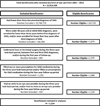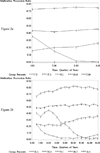Patterns of Glaucoma Medication Adherence over Four Years of Follow-Up
- PMID: 26319441
- PMCID: PMC4581955
- DOI: 10.1016/j.ophtha.2015.06.039
Patterns of Glaucoma Medication Adherence over Four Years of Follow-Up
Abstract
Purpose: To assess longer-term patterns of glaucoma medication adherence and identify whether patterns established during the first year of medication use persist during 3 subsequent years of follow-up.
Design: Retrospective, longitudinal cohort analysis.
Participants: Beneficiaries aged ≥40 years who were enrolled in a United States (US)-managed care plan for ≥7 years between 2001 and 2012 and newly diagnosed and treated for open-angle glaucoma.
Methods: For each enrollee, we quantified medication adherence using the medication possession ratio. Group-based trajectory modeling (GBTM) was applied to identify patterns of adherence for 1 and 4 years of follow-up. The percent of beneficiaries who remained in the same trajectory group in the 1- and 4-year models was tabulated to evaluate group stability. Factors impacting adherence at 1 and 4 years were identified using regression analyses.
Main outcome measures: Patterns of glaucoma medication adherence.
Results: Of the 1234 eligible beneficiaries, GBTM identified 5 distinct glaucoma medication adherence patterns in both the 1-year and 4-year follow-up periods. These groups were as follows: (1) never adherent after their index prescription fill (7.5% and 15.6% of persons in the 1- and 4-year models, respectively); (2) persistently very poor adherence (14.9% and 23.4% of persons in the 1- and 4-year models, respectively); (3) declining adherence (9.5% and 9.1% of persons in the 1- and 4-year models, respectively); (4) persistently moderate adherence (48.1% and 37.0% of persons in the 1- and 4-year models, respectively); and (5) persistently good adherence (20.0% and 15.0% of persons in the 1- and 4-year models, respectively). More than 90% of beneficiaries in the 4 groups with the worst and best adherence patterns (groups 1, 2, 3, 5) maintained their patterns from their first year throughout their 4 years of follow-up. Those with persistently moderate adherence (group 4), the largest group, were most likely to change groups from 1 to 4 years of follow-up. Persons with the best adherence over 4 years were more likely to be white, to be older, to earn >$60 000/year, and to have more eye care visits (P < 0.05 for all comparisons). Those with a higher initial copayment cost had lower adherence rates (β = -0.06/dollar, P = 0.03).
Conclusions: For most patients who were newly prescribed glaucoma medications, adherence patterns observed in the first year of treatment reflect adherence patterns over the subsequent 3 years. Investing resources in both identifying and helping patients with suboptimal adherence patterns over the first year may have a large impact on longer-term adherence.
Copyright © 2015 American Academy of Ophthalmology. Published by Elsevier Inc. All rights reserved.
Conflict of interest statement
Figures



Similar articles
-
Impact of the introduction of generic latanoprost on glaucoma medication adherence.Ophthalmology. 2015 Apr;122(4):738-47. doi: 10.1016/j.ophtha.2014.11.022. Epub 2015 Feb 9. Ophthalmology. 2015. PMID: 25680226 Free PMC article.
-
Persistence of topical glaucoma medication: a nationwide population-based cohort study in Taiwan.JAMA Ophthalmol. 2014 Dec;132(12):1446-52. doi: 10.1001/jamaophthalmol.2014.3333. JAMA Ophthalmol. 2014. PMID: 25211300
-
The Most Common Barriers to Glaucoma Medication Adherence: A Cross-Sectional Survey.Ophthalmology. 2015 Jul;122(7):1308-16. doi: 10.1016/j.ophtha.2015.03.026. Epub 2015 Apr 24. Ophthalmology. 2015. PMID: 25912144 Free PMC article.
-
Adherence and persistence with glaucoma therapy.Surv Ophthalmol. 2008 Nov;53 Suppl1:S57-68. doi: 10.1016/j.survophthal.2008.08.002. Surv Ophthalmol. 2008. PMID: 19038625 Review.
-
A Novel Approach to Helping People with Glaucoma Use Their Drops Routinely.Optom Vis Sci. 2019 May;96(5):331-334. doi: 10.1097/OPX.0000000000001366. Optom Vis Sci. 2019. PMID: 31046015 Review.
Cited by
-
Better tolerance of preservative-free latanoprost compared to preserved glaucoma eye drops: the 12-month real-life FREE study.Clin Ophthalmol. 2018 Nov 26;12:2399-2407. doi: 10.2147/OPTH.S176605. eCollection 2018. Clin Ophthalmol. 2018. PMID: 30538423 Free PMC article.
-
Ophthalmic medication price variation across the United States: Anti-inflammatory medications.Ther Adv Ophthalmol. 2019 Jul 17;11:2515841419863638. doi: 10.1177/2515841419863638. eCollection 2019 Jan-Dec. Ther Adv Ophthalmol. 2019. PMID: 31360908 Free PMC article.
-
Identifying risk factors for blindness from primary open-angle glaucoma by race: a case-control study.Clin Ophthalmol. 2018 Feb 20;12:377-383. doi: 10.2147/OPTH.S143417. eCollection 2018. Clin Ophthalmol. 2018. PMID: 29503525 Free PMC article.
-
The Effect of an Educational Intervention on Adherence to Intraocular Pressure-Lowering Medications in a Large Cohort of Older Adults with Glaucoma.J Manag Care Spec Pharm. 2018 Dec;24(12):1284-1294. doi: 10.18553/jmcp.2018.17465. Epub 2018 May 31. J Manag Care Spec Pharm. 2018. PMID: 29848186 Free PMC article. Clinical Trial.
-
Enhancing Health Literacy and Self-Management in Glaucoma Patients: Evidence from a Nurse-Led Educational Intervention.Healthcare (Basel). 2025 Apr 9;13(8):861. doi: 10.3390/healthcare13080861. Healthcare (Basel). 2025. PMID: 40281810 Free PMC article.
References
-
- Olthoff CM, Schouten JS, van de Borne BW, Webers CA. Noncompliance with ocular hypotensive treatment in patients with glaucoma or ocular hypertension an evidence-based review. Ophthalmology. 2005;112:953–961. - PubMed
-
- Schwartz GF, Quigley HA. Adherence and adherence with glaucoma therapy. Surv Ophthalmol. 2008;53(suppl1):S57–S68. - PubMed
-
- Hwang DK, Liu CJ, Pu CY, et al. Adherence of topical glaucoma medication: a nationwide population-based cohort study in Taiwan. JAMA Ophthalmol. 2014 Dec;132(12):1446–1452. - PubMed
-
- Okeke CO, Quigley HA, Jampel HD, et al. Adherence with Topical Glaucoma Medication Monitored Electronically: The Travatan Dosing Aid Study. Ophthalmology. 2009;116:191–199. - PubMed
Publication types
MeSH terms
Substances
Grants and funding
LinkOut - more resources
Full Text Sources
Other Literature Sources
Medical

